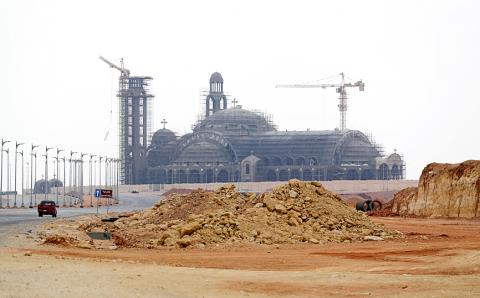Talks between Egypt and Chinese builder China Fortune Land Development Co (CFLD, 華夏幸福) for a US$20 billion development in the new administrative capital have fallen through over disagreements on how to share revenue from the project, Egyptian officials said.
Two years of tough negotiations came to an end after Egyptian authorities sent a response to the final proposal by the Shanghai-listed CFLD on developing 6,070 hectares over 25 years in the new capital east of Cairo.
“We didn’t hear back,” said General Ahmed Zaki Abdeen, head of Administrative Capital for Urban Development, the firm created to oversee the construction of the new capital. “The talks have stopped.”

Photo: Reuters
Failure to reach an agreement will likely raise questions over Egypt’s ability to attract crucial foreign direct investments to propel economic growth, but it might not deter Chinese state-owned companies from pursuing other opportunities in Egypt, thanks to strong ties between the two governments.
CFLD declined to comment.
Authorities could collaborate with CFLD on another development, although not in the new capital, Egyptian Deputy Minister of Housing, Utilities and Urban Communities Khaled Abbas said.
“This could be an alternative to the new capital project,” he said by telephone, without elaborating.
Egypt has struggled to attract major foreign investments outside the oil and gas industry. Foreign direct investment fell US$200 million to US$7.7 billion in the fiscal year that ended in June.
With the exception of the business district, which is being developed by another Chinese company, work on the new capital has so far been undertaken by the housing ministry, the military and Egyptian contractors who have bought smaller parcels of land outright.
Egypt wanted 40 percent of the project revenue, while CFLD offered 33 percent, Administrative Capital for Urban Development spokesman Khaled al-Husseiny said.
“We found that to be unacceptable especially they were going to have a premium plot,” he said.
CFLD began talks with the Egyptian government in June 2016 and signed a memorandum of understanding in October that year agreeing to plan, develop, manage and market a section of the new city.
The new administrative capital is one of several mega-projects launched by Egyptian President Abdel-Fattah al-Sisi since taking office in 2014 in an effort to reboot the economy and leave his mark on the most-populous Arab nation.
The three-phase administrative capital project envisages transforming a 700km2 swath of desert into a hub for government buildings, foreign embassies and major firms.
That project aims to ease pressure on traffic-choked Cairo, the sprawling 1,000-year-old city that is home to 23 million people. The first phase is due to be completed by the middle of next year.

With this year’s Semicon Taiwan trade show set to kick off on Wednesday, market attention has turned to the mass production of advanced packaging technologies and capacity expansion in Taiwan and the US. With traditional scaling reaching physical limits, heterogeneous integration and packaging technologies have emerged as key solutions. Surging demand for artificial intelligence (AI), high-performance computing (HPC) and high-bandwidth memory (HBM) chips has put technologies such as chip-on-wafer-on-substrate (CoWoS), integrated fan-out (InFO), system on integrated chips (SoIC), 3D IC and fan-out panel-level packaging (FOPLP) at the center of semiconductor innovation, making them a major focus at this year’s trade show, according

DEBUT: The trade show is to feature 17 national pavilions, a new high for the event, including from Canada, Costa Rica, Lithuania, Sweden and Vietnam for the first time The Semicon Taiwan trade show, which opens on Wednesday, is expected to see a new high in the number of exhibitors and visitors from around the world, said its organizer, SEMI, which has described the annual event as the “Olympics of the semiconductor industry.” SEMI, which represents companies in the electronics manufacturing and design supply chain, and touts the annual exhibition as the most influential semiconductor trade show in the world, said more than 1,200 enterprises from 56 countries are to showcase their innovations across more than 4,100 booths, and that the event could attract 100,000 visitors. This year’s event features 17

EXPORT GROWTH: The AI boom has shortened chip cycles to just one year, putting pressure on chipmakers to accelerate development and expand packaging capacity Developing a localized supply chain for advanced packaging equipment is critical for keeping pace with customers’ increasingly shrinking time-to-market cycles for new artificial intelligence (AI) chips, Taiwan Semiconductor Manufacturing Co (TSMC, 台積電) said yesterday. Spurred on by the AI revolution, customers are accelerating product upgrades to nearly every year, compared with the two to three-year development cadence in the past, TSMC vice president of advanced packaging technology and service Jun He (何軍) said at a 3D IC Global Summit organized by SEMI in Taipei. These shortened cycles put heavy pressure on chipmakers, as the entire process — from chip design to mass

Germany is to establish its first-ever national pavilion at Semicon Taiwan, which starts tomorrow in Taipei, as the country looks to raise its profile and deepen semiconductor ties with Taiwan as global chip demand accelerates. Martin Mayer, a semiconductor investment expert at Germany Trade & Invest (GTAI), Germany’s international economic promotion agency, said before leaving for Taiwan that the nation is a crucial partner in developing Germany’s semiconductor ecosystem. Germany’s debut at the international semiconductor exhibition in Taipei aims to “show presence” and signal its commitment to semiconductors, while building trust with Taiwanese companies, government and industry associations, he said. “The best outcome